
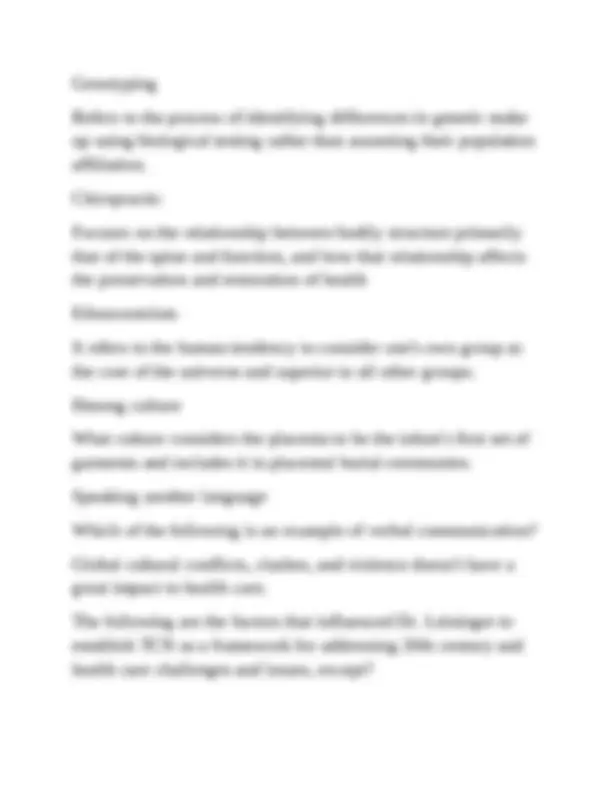
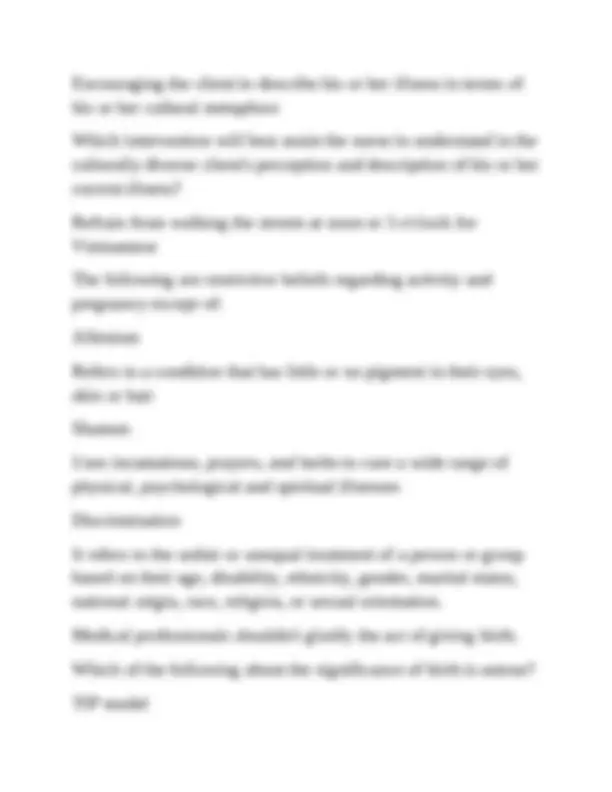
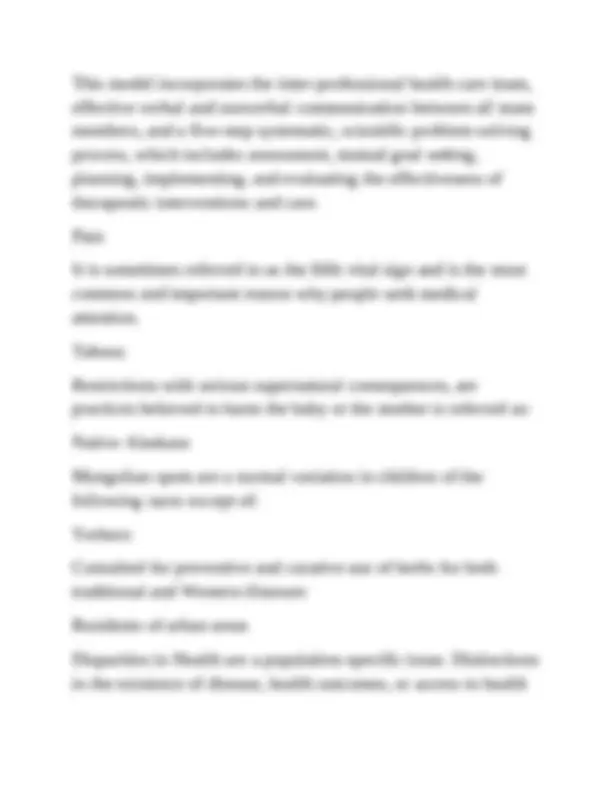
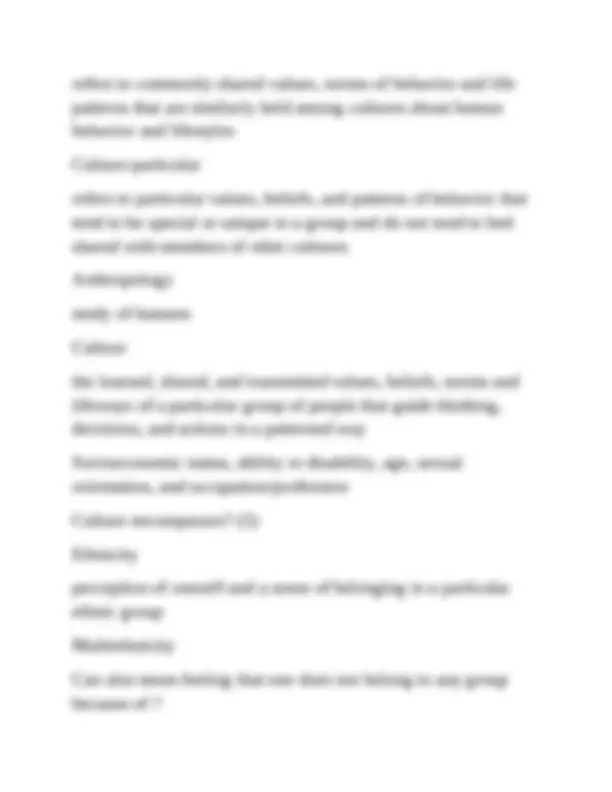
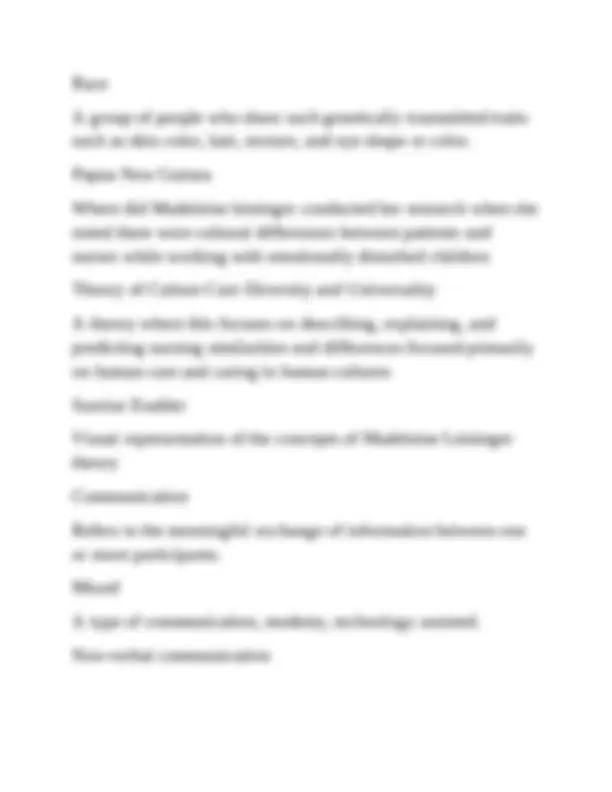
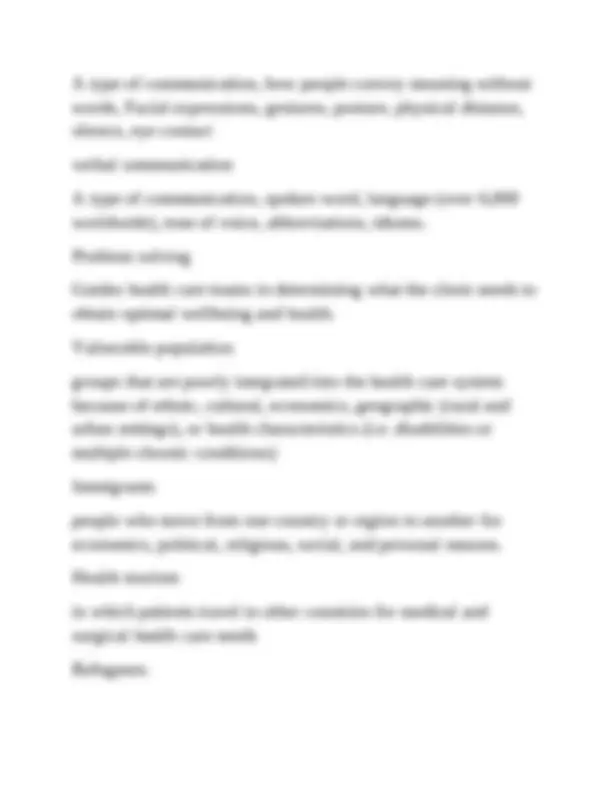
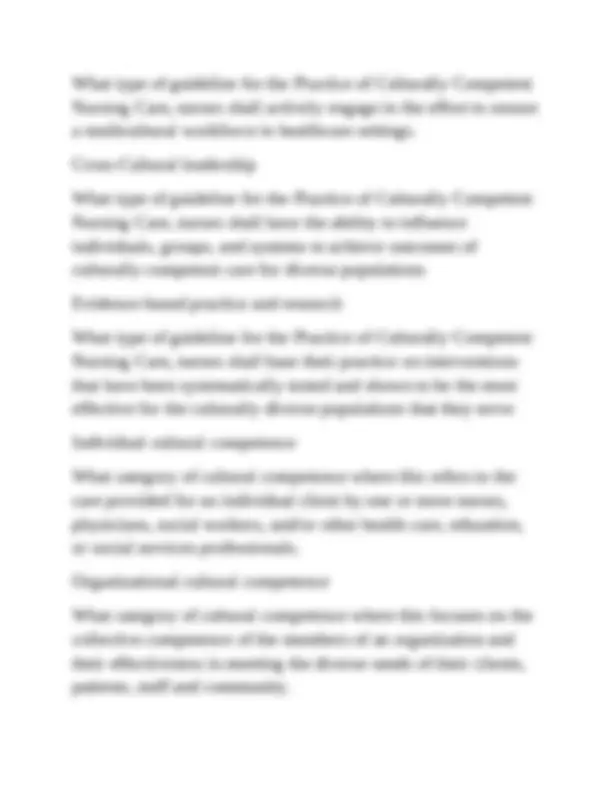
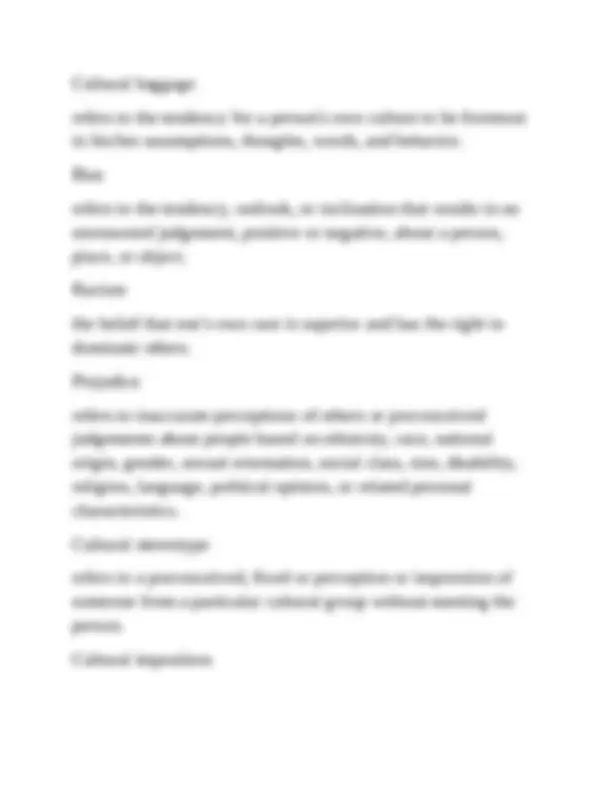

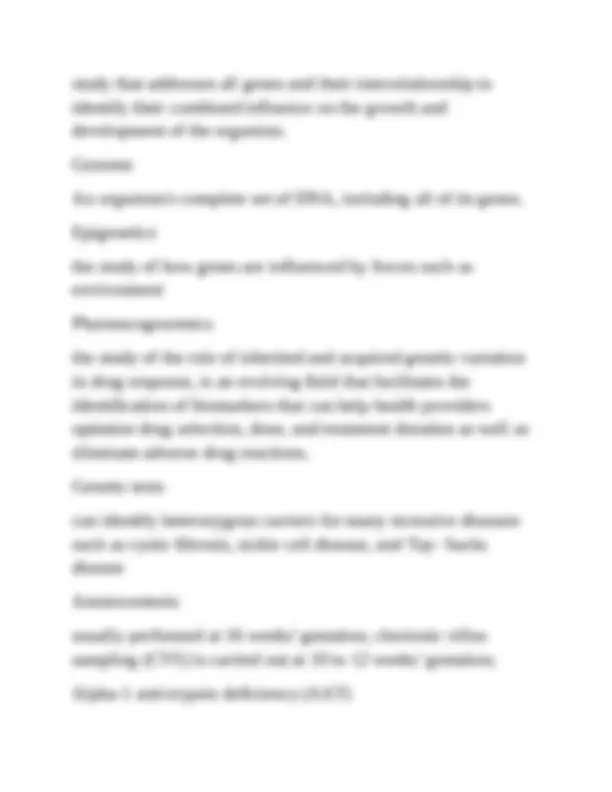
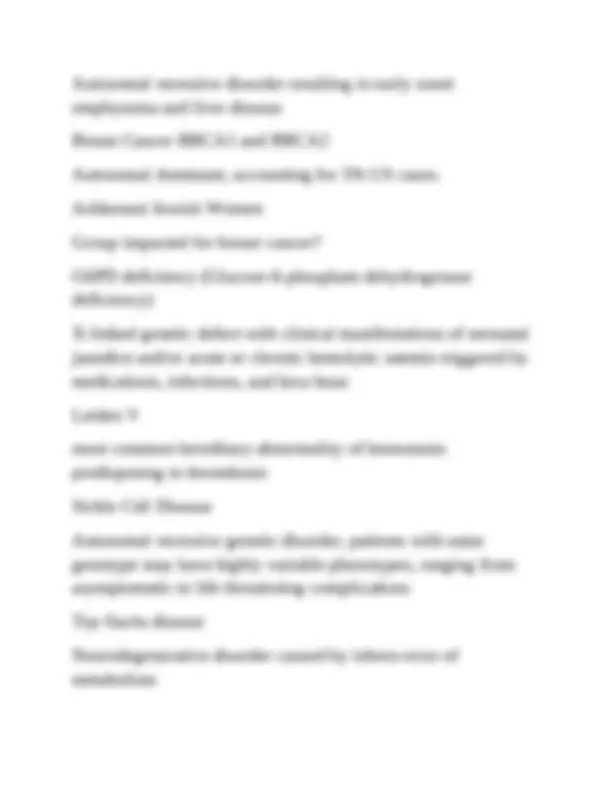
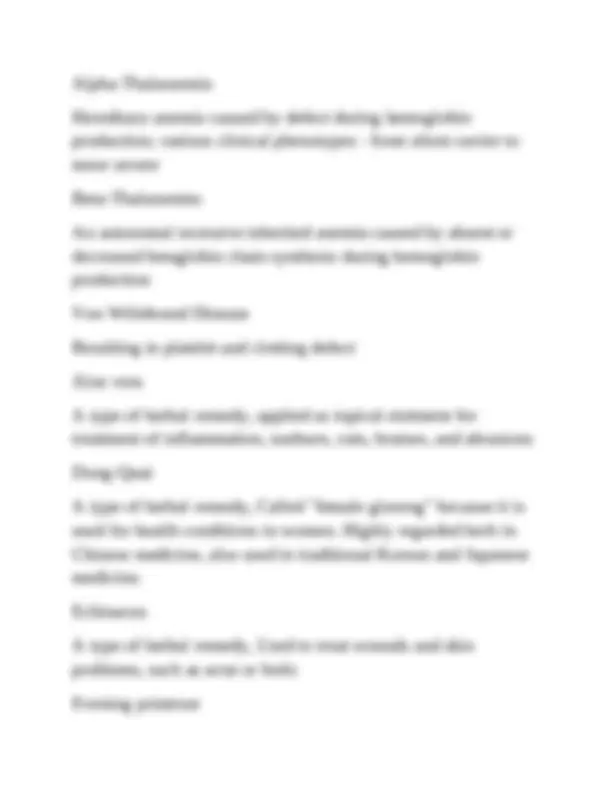
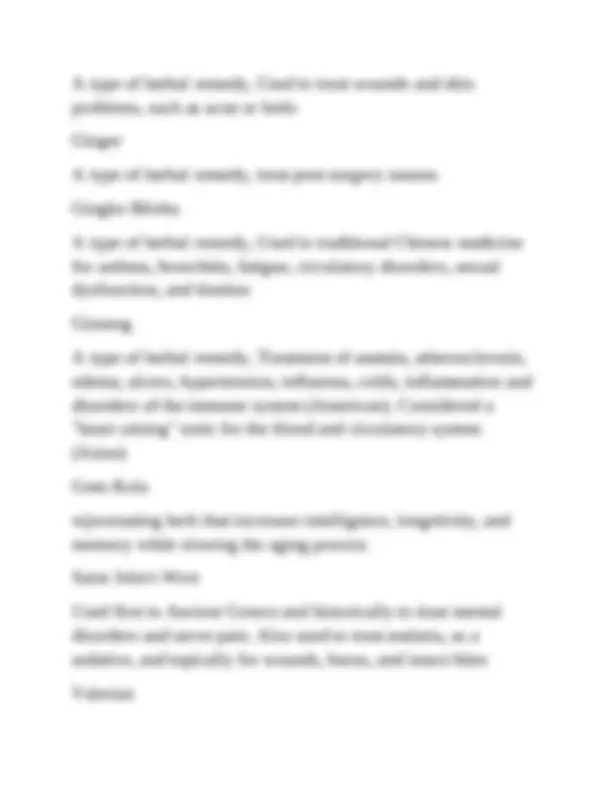
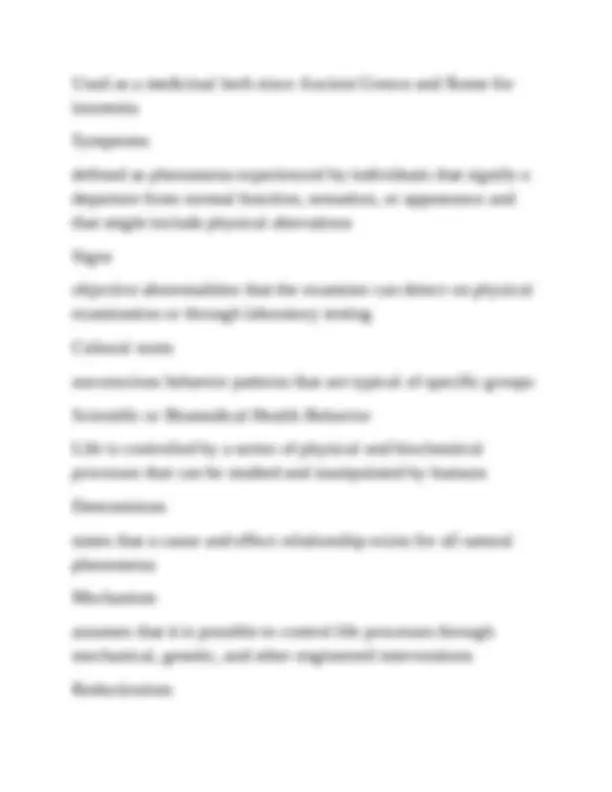
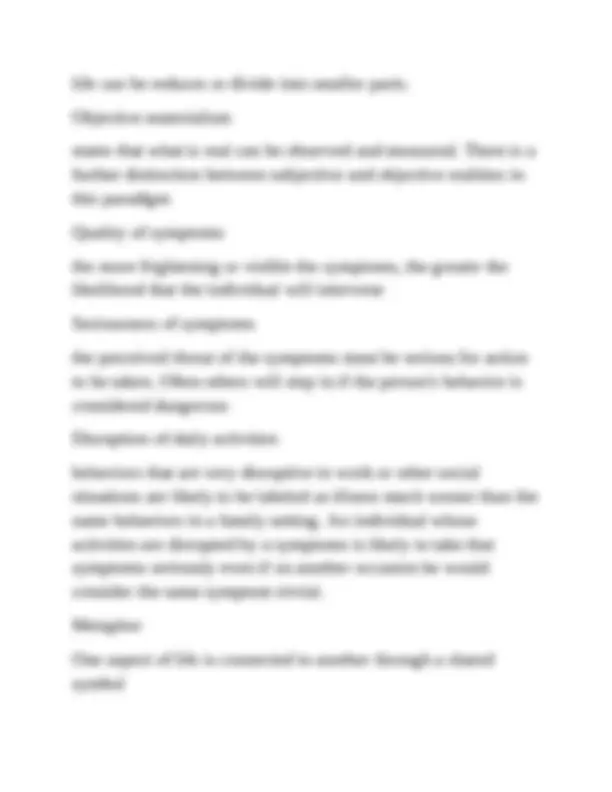
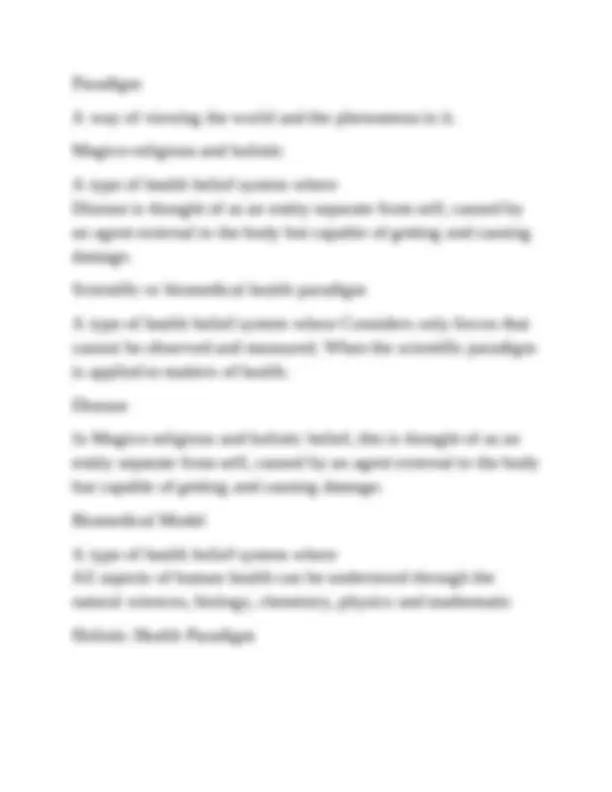
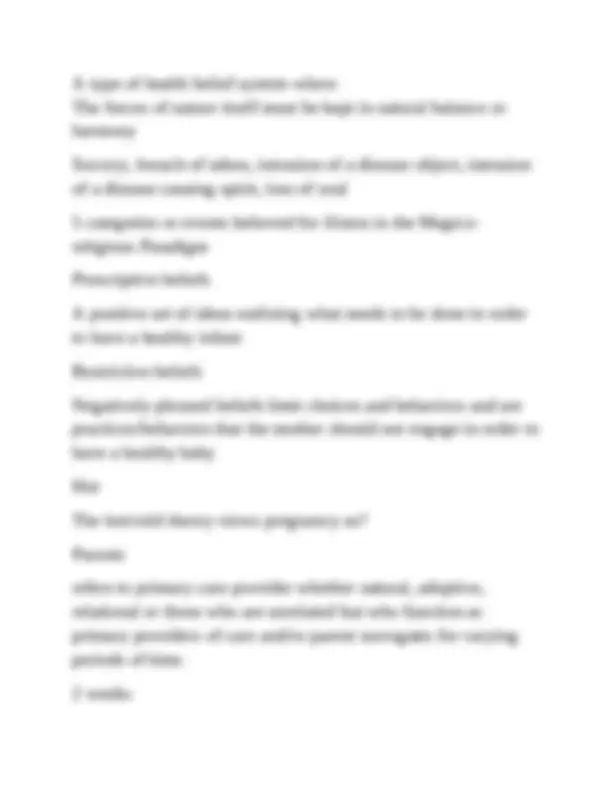
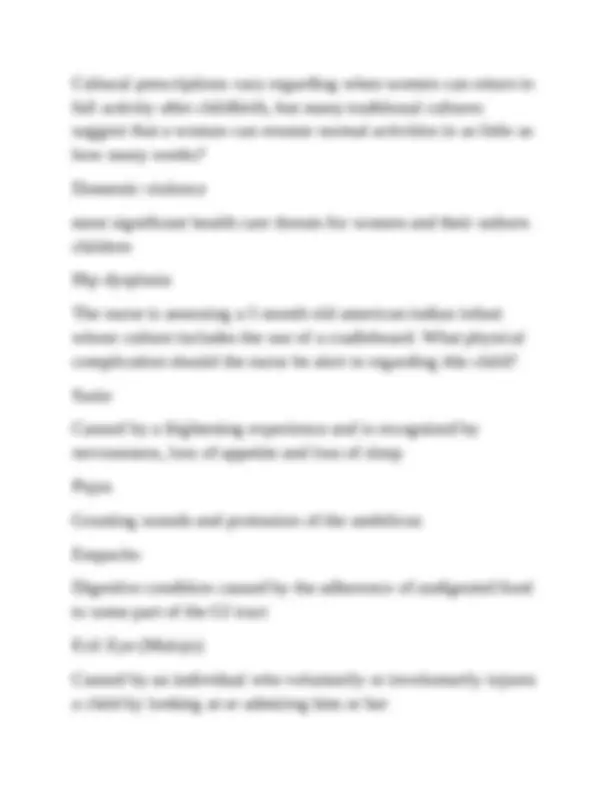
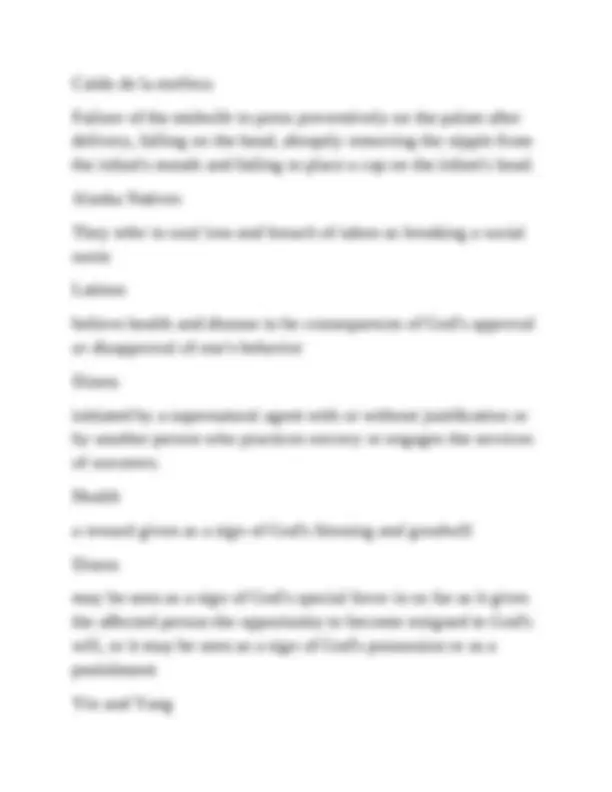
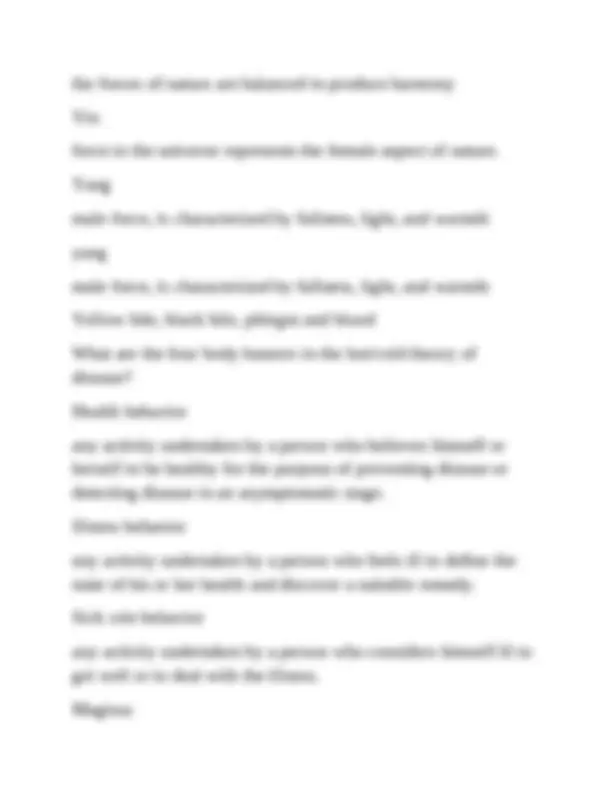
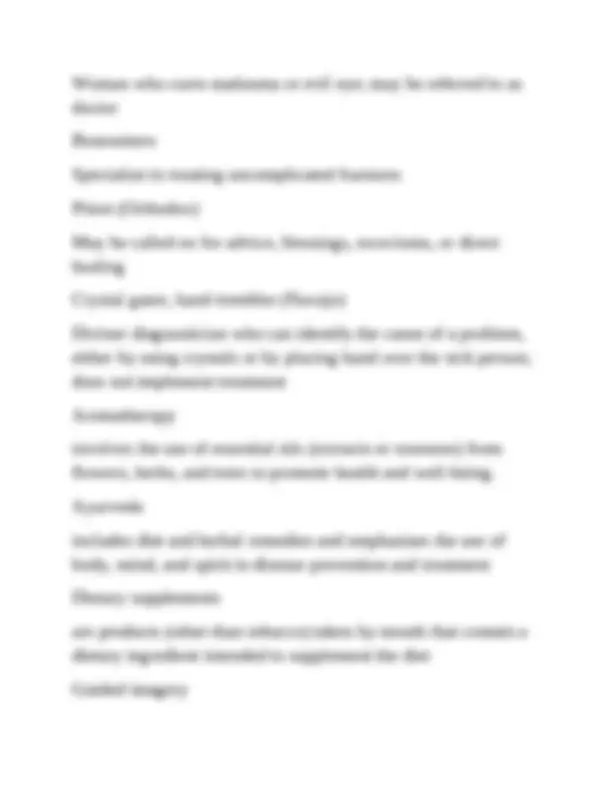

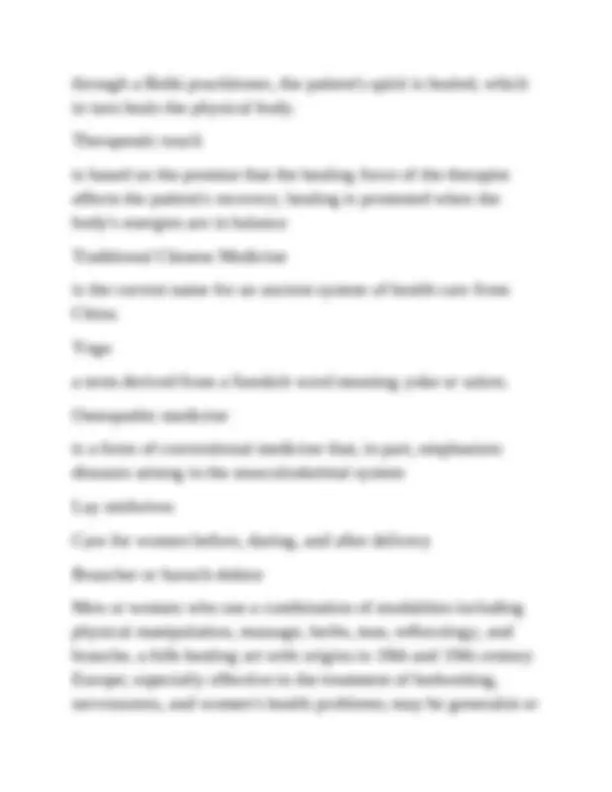
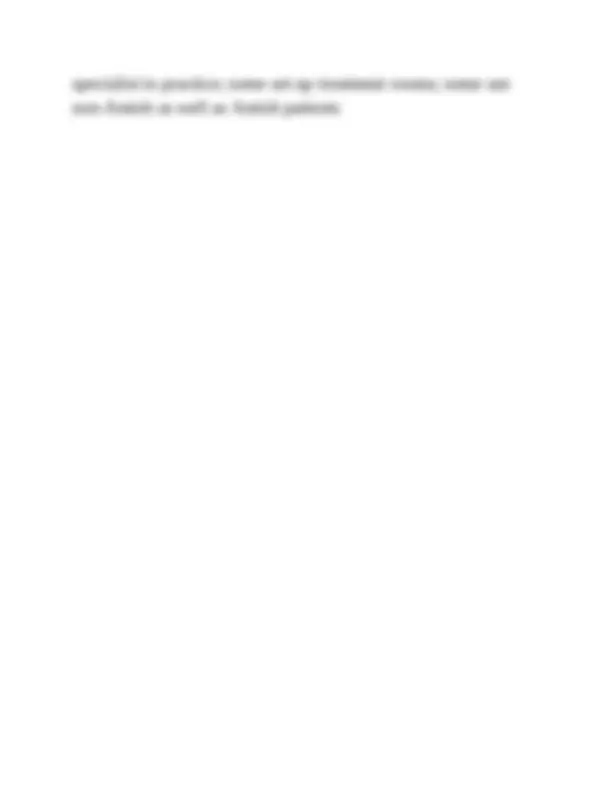


Study with the several resources on Docsity

Earn points by helping other students or get them with a premium plan


Prepare for your exams
Study with the several resources on Docsity

Earn points to download
Earn points by helping other students or get them with a premium plan
Community
Ask the community for help and clear up your study doubts
Discover the best universities in your country according to Docsity users
Free resources
Download our free guides on studying techniques, anxiety management strategies, and thesis advice from Docsity tutors
A collection of questions and answers related to transcultural nursing, covering topics such as cultural influences on healthcare, cultural sensitivity, and culturally competent care. It explores various cultural practices and beliefs, including those related to childbirth, pain management, and health disparities. The document aims to enhance understanding of cultural diversity in healthcare settings.
Typology: Exams
1 / 32

This page cannot be seen from the preview
Don't miss anything!

























Latinos A culture of a country that the male child is expected to maintain strong control over his emotions, and not cry in the presence of others; therefore, a child crying in pain may be interpreted one way by a nurse and dismissed as inappropriate gender-related behavior by a parent. Taboos A number of factors influence childbearing practices for Filipino women includes all except of: Culture bound syndrome Refers to more than 200 disorders created by personal, social and cultural reactions to malfunctioning biological or psychological processes and can be understood only within defined context of meaning and social relationship Qigong It is a component of traditional Chinese medicine that combines movement, meditation, and regulation of breathing to enhance the flow of qi in the body improve blood circulation, and enhance immune function Diversity
Refers to the client's distinctiveness in terms of race, ethnicity, national origin, socioeconomic background, age, gender, sexual orientation, philosophical and religious ideology, lifestyle, level of education, literacy, marital status, physical, emotional, and psychological ability, political ideology, size, and other characteristics used to compare or categorize people. Vaginal examination What tests might be intrusive or embarrassing to pregnant women? Attentively listen to the complaints of the patient. In the clinical setting, what caring behaviors do you employ? Nurses who engaged in critical reflection on their own values, beliefs, and cultural heritage to gain an understanding of how these characteristics and issues can impact culturally congruent nursing care. Which statement best describes "Cultural Self-Assessment"? Family income status The following are the indicators of child health status, except? Post partum depression Identifying and reporting of this condition in non-Western cultures may be delayed by culturally unacceptable labelling of the varying symptoms and treatment differences among post- partum women.
Encouraging the client to describe his or her illness in terms of his or her cultural metaphors Which intervention will best assist the nurse in understand in the culturally diverse client's perception and description of his or her current illness? Refrain from walking the streets at noon or 5 o'clock for Vietnamese The following are restrictive beliefs regarding activity and pregnancy except of: Albinism Refers to a condition that has little or no pigment in their eyes, skin or hair Shaman Uses incantations, prayers, and herbs to cure a wide range of physical, psychological and spiritual illnesses Discrimination It refers to the unfair or unequal treatment of a person or group based on their age, disability, ethnicity, gender, marital status, national origin, race, religion, or sexual orientation. Medical professionals shouldn't glorify the act of giving birth. Which of the following about the significance of birth is untrue? TIP model
This model incorporates the inter-professional health care team, effective verbal and nonverbal communication between all team members, and a five-step systematic, scientific problem-solving process, which includes assessment, mutual goal setting, planning, implementing, and evaluating the effectiveness of therapeutic interventions and care. Pain It is sometimes referred to as the fifth vital sign and is the most common and important reason why people seek medical attention. Taboos Restrictions with serious supernatural consequences, are practices believed to harm the baby or the mother is referred as: Native Alaskans Mongolian spots are a normal variation in children of the following races except of: Yerbero Consulted for preventive and curative use of herbs for both traditional and Western illnesses Residents of urban areas Disparities in Health are a population-specific issue. Distinctions in the existence of disease, health outcomes, or access to health
Which nursing intervention best shows compliance with offering linguistically appropriate services for a culturally diverse population? "I'm always careful to apologize when I'm having difficulty understanding a client" Which statement demonstrates the nurse's ability to communicate sincerely and respectfully with a culturally diverse client population? Herbalist Knowledgeable in diagnosis of illness and herbal remedies. Patient's communication style You are the nurse caring for a patient who is a recent immigrant to the United States from Mexico. Which of the following variables would you prioritize when performing an assessment of the patients cultural beliefs? Transcultural nursing the blending of nursing and anthropology Madeleine Leininger Who conceptualized transcultural nursing? Culture-universal
refers to commonly shared values, norms of behavior and life patterns that are similarly held among cultures about human behavior and lifestyles Culture-particular refers to particular values, beliefs, and patterns of behavior that tend to be special or unique to a group and do not tend to bed shared with members of other cultures Anthropology study of humans Culture the learned, shared, and transmitted values, beliefs, norms and lifeways of a particular group of people that guide thinking, decisions, and actions in a patterned way Socioeconomic status, ability or disability, age, sexual orientation, and occupation/profession Culture encompasses? (5) Ethnicity perception of oneself and a sense of belonging to a particular ethnic group Multiethnicity Can also mean feeling that one does not belong to any group because of?
A type of communication, how people convey meaning without words, Facial expressions, gestures, posture, physical distance, silence, eye contact verbal communication A type of communication, spoken word, language (over 6, worldwide), tone of voice, abbreviations, idioms. Problem solving Guides health care teams in determining what the client needs to obtain optimal wellbeing and health. Vulnerable population groups that are poorly integrated into the health care system because of ethnic, cultural, economics, geographic (rural and urban settings), or health characteristics (i.e. disabilities or multiple chronic conditions) Immigrants people who move from one country or region to another for economics, political, religious, social, and personal reasons. Health tourism in which patients travel to other countries for medical and surgical health care needs Refugeees
people who flee their country of origin for fear of persecution based on ethnicity, race, religion, political opinion or related reasons) and other casualties of civil unrest or war in politically unstable parts of the world. Interprofessional collaborative practice refers to multiple health providers from different professional backgrounds working together with patients, families, caregivers, and communities to deliver the highest quality care (WHO, 2010). Culturally competent care an extension of interprofessional collaborative practice Knowledge of cultures What type of guideline for the Practice of Culturally Competent Nursing Care, nurses shall gain an understanding of the perspectives, traditions, values. practices and family systems of culturally diverse individuals, families, communities, and populations they care for, as well as knowledge of the complex variables that affect the achievement of health and well-being Education and training in culturally competent care What type of guideline for the Practice of Culturally Competent Nursing Care, nurses shall be educationally prepared to provide culturally congruent health care. Critical reflection
What type of guideline for the Practice of Culturally Competent Nursing Care, nurses shall actively engage in the effort to ensure a multicultural workforce in healthcare settings. Cross-Cultural leadership What type of guideline for the Practice of Culturally Competent Nursing Care, nurses shall have the ability to influence individuals, groups, and systems to achieve outcomes of culturally competent care for diverse populations Evidence-based practice and research What type of guideline for the Practice of Culturally Competent Nursing Care, nurses shall base their practice on interventions that have been systematically tested and shown to be the most effective for the culturally diverse populations that they serve Individual cultural competence What category of cultural competence where this refers to the care provided for an individual client by one or more nurses, physicians, social workers, and/or other health care, education, or social services professionals. Organizational cultural competence What category of cultural competence where this focuses on the collective competence of the members of an organization and their effectiveness in meeting the diverse needs of their clients, patients, staff and community.
Cultural baggage refers to the tendency for a person's own culture to be foremost in his/her assumptions, thoughts, words, and behavior. Bias refers to the tendency, outlook, or inclination that results in an unreasoned judgement, positive or negative, about a person, place, or object. Racism the belief that one's own race is superior and has the right to dominate others. Prejudice refers to inaccurate perceptions of others or preconceived judgements about people based on ethnicity, race, national origin, gender, sexual orientation, social class, size, disability, religion, language, political opinion, or related personal characteristics. Cultural stereotype refers to a preconceived, fixed or perception or impression of someone from a particular cultural group without meeting the person. Cultural imposition
defined as the loss of greater than 40 decibels in the better ear in adults and the loss of greater than 30 decibels in the better ear in children 20% and 9% about ___ of the US population speaks a language other than English at home, and __ has limited English proficiency. 2050 By year ___, more than half the population will come from racial. Cultural Assessment Refers to a systematic, comprehensive examination of individuals, families groups, and communities regarding their health-related cultural beliefs, values and practices Process refers to how to approach the client, consideration of verbal and non-verbal communication, and the sequence and order in which data are gathered Content consists of the actual data categories in which information about clients is gathered. Genetics
a branch of biology that studies heredity and the variations of inherited characteristics Cultural Affliation one of the first areas the nurse should assess in the cultural self- assessment Well-client history is used to assess lifestyle; includes: activity, exercise, diet, and related personal behaviors and choices that nurses may gather to identify potential risk factors for disease. History combined with the objective data from the physical examination and laboratory results to form a diagnosis about the health status of a person Ill client health history includes a chronologic record of the health problems Health history provides valuable information about the coping strategies and health-related behaviors and responses used by previously by clients and family members. Genomics
Autosomal recessive disorder resulting in early onset emphysema and liver disease Breast Cancer BRCA1 and BRCA Autosomal dominant; accounting for 5% US cases. Ashkenazi Jewish Women Group impacted for breast cancer? G6PD deficiency (Glucose-6-phosphate dehydrogenase deficiency) X-linked genetic defect with clinical manifestations of neonatal jaundice and/or acute or chronic hemolytic anemia triggered by medications, infections, and fava bean Leiden V most common hereditary abnormality of hemostasis predisposing to thrombosis Sickle Cell Disease Autosomal recessive genetic disorder, patients with same genotype may have highly variable phenotypes, ranging from asymptomatic to life threatening complications Tay-Sachs disease Neurodegenerative disorder caused by inborn error of metabolism
Alpha-Thalassemia Hereditary anemia caused by defect during hemoglobin production; various clinical phenotypes - from silent carrier to more severe Beta-Thalassemia An autosomal recessive inherited anemia caused by absent or decreased betaglobin chain synthesis during hemoglobin production Von Willebrand Disease Resulting in platelet and clotting defect Aloe vera A type of herbal remedy, applied as topical ointment for treatment of inflammation, sunburn, cuts, bruises, and abrasions Dong-Quai A type of herbal remedy, Called "female ginseng" because it is used for health conditions in women. Highly regarded herb in Chinese medicine, also used in traditional Korean and Japanese medicine. Echinacea A type of herbal remedy, Used to treat wounds and skin problems, such as acne or boils Evening primrose